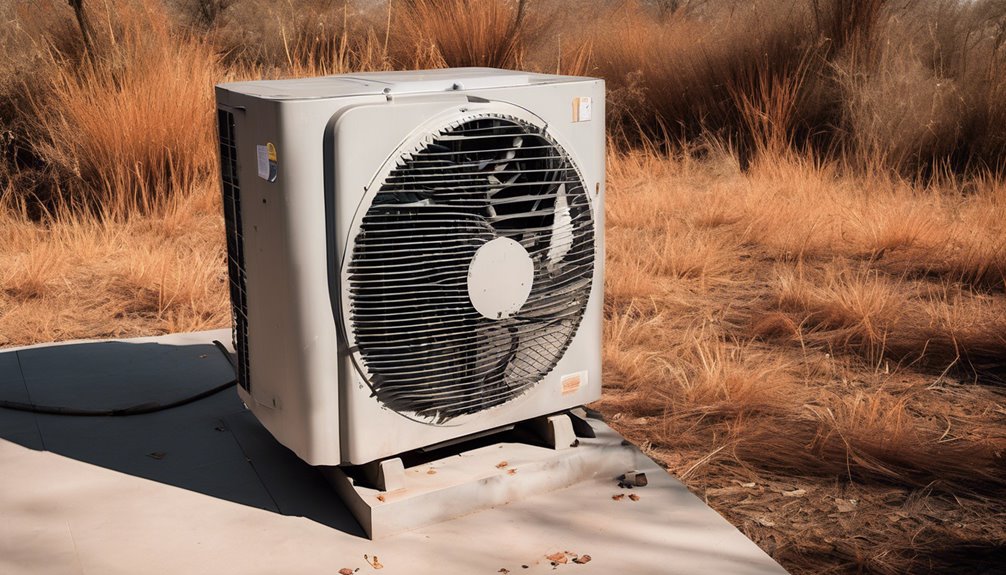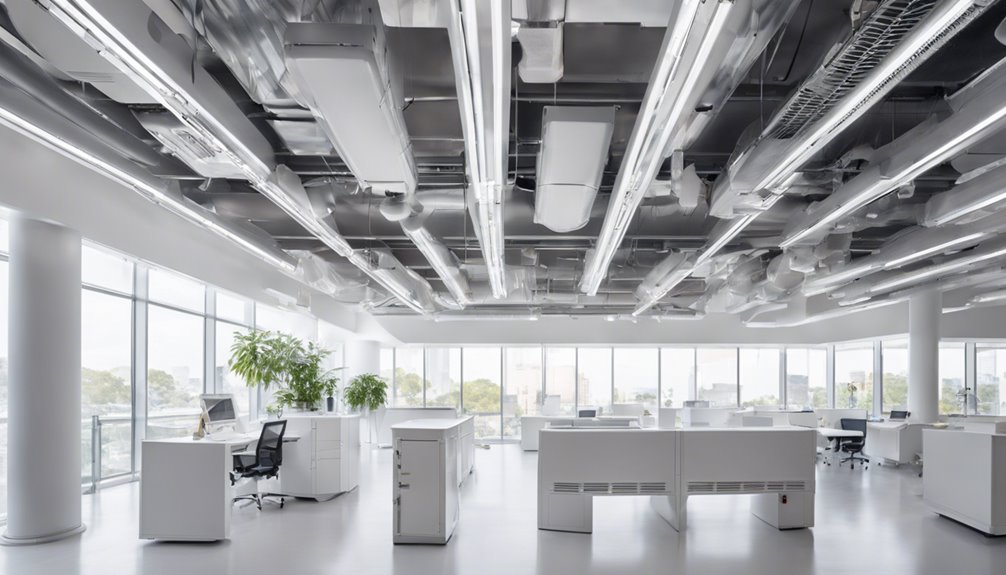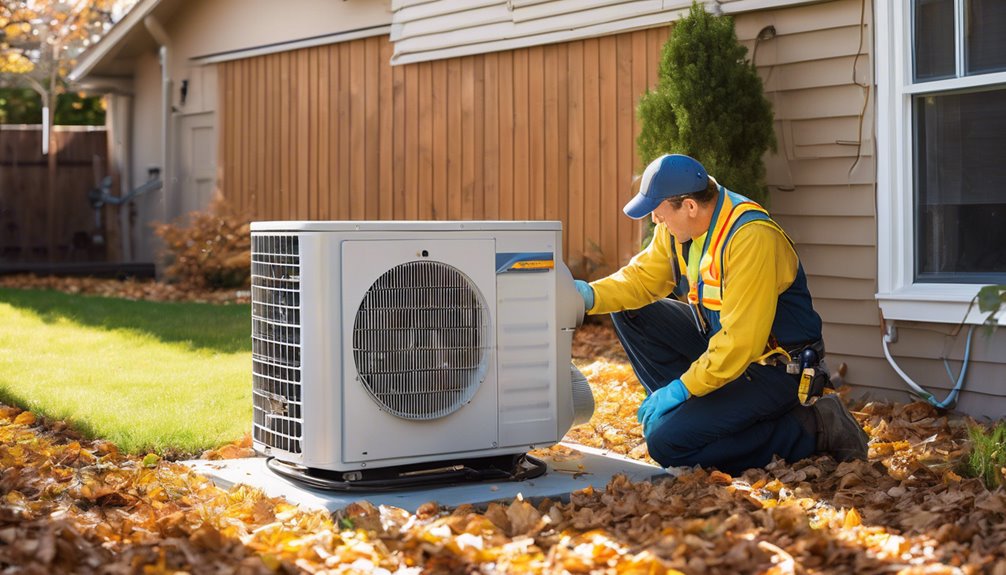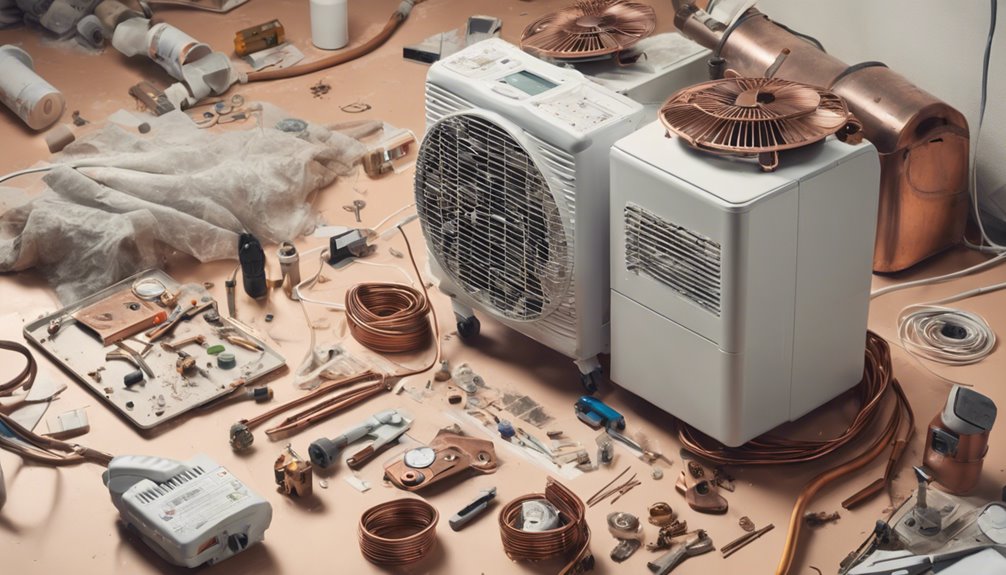If your AC outdoor fan isn't spinning but the compressor is running, you're not alone. This common issue is often caused by worn-out fan bearings, rust buildup, debris accumulation, or electrical problems. You might've noticed a humming sound from the motor, but the fan blades remain stationary. Don't worry, identifying the root cause is just the first step, and by troubleshooting further, you'll be able to diagnose and potentially fix the problem, getting your AC running smoothly again.
Key Takeaways
- A faulty capacitor is a common cause of a non-spinning outdoor fan, even if the compressor is running, and can be a simple and inexpensive fix.
- Worn-out fan bearings, rust buildup, or debris can also prevent the fan from spinning, despite the compressor running normally.
- Electrical surges or loose wiring can damage the motor's internal components, causing the fan to fail to spin while the compressor continues to run.
- A faulty thermostat or sensor malfunction can prevent the fan from spinning, even if the compressor is running, and can compromise the entire cooling system.
- Overheating due to a faulty motor or electrical issues can also cause the fan to stop spinning, while the compressor continues to run, leading to further damage.
Common Causes of a Non-Spinning Outdoor Fan
If your AC outdoor fan isn't spinning, it's likely due to one of several common issues.
One possible cause is worn-out fan bearings. Over time, the bearings can wear down, causing the fan to seize up and stop spinning.
Another culprit might be rust buildup on the fan blades or motor housing. When rust accumulates, it can create friction that prevents the fan from rotating freely.
You might also want to check if the fan is clogged with debris like leaves or twigs, which can impede its rotation.
Finally, a faulty capacitor or loose wiring could be preventing the fan from receiving the necessary power to spin.
Signs of a Faulty Outdoor Fan Motor
When you investigate your non-spinning outdoor fan, you'll likely notice some telltale signs of a faulty motor.
For instance, you might hear a humming sound coming from the motor, but the fan blades remain stationary. If the motor isn't rotating, it's likely the culprit behind your fan's inability to spin.
Motor Humming Sound
What's behind that strange humming noise coming from your AC outdoor fan?
It could be a sign of a faulty motor. When you hear a humming sound, it usually indicates that the motor is receiving power but can't rotate.
This might be due to a faulty motor bearing, which prevents the motor from spinning. Another possible cause is an electrical surge that damaged the motor's internal components.
If you notice a humming sound, it's essential to address the issue promptly to avoid further damage to your AC unit. Remember, a humming motor isn't spinning, which means your AC isn't cooling efficiently, and your energy bills might increase.
Fan Blades Stationary
A stationary outdoor fan is a clear indication that something is amiss.
You've checked the compressor, and it's running smoothly, but the fan blades aren't budging. This is a sign of a faulty outdoor fan motor.
When the fan blades aren't spinning, it affects the overall airflow and fan speed. The lack of air flow can cause the system to overheat, leading to further damage.
You may notice a decrease in cooling performance or an increase in energy bills. It's essential to address this issue promptly to prevent more costly repairs down the line.
Motor Not Rotating
Since you've ruled out compressor issues, the lack of rotation in your AC outdoor fan motor is likely the culprit behind your system's poor performance.
A faulty motor can cause your entire system to malfunction, leading to increased energy bills and decreased comfort.
- Your motor bearings might be worn out, causing friction and heat buildup that prevents the motor from spinning.
- A worn shaft can also hinder the motor's rotation, leading to a complete system failure.
- You might hear strange noises or humming sounds coming from the outdoor unit, indicating a faulty motor.
- Your system could be overheating, causing the motor to shut down as a safety precaution.
- A faulty motor can even lead to a complete system breakdown, leaving you without air conditioning on a hot summer day.
Capacitor Issues and Their Effects
Faulty capacitors are a common culprit behind an AC outdoor fan's failure to spin.
You might be surprised to know that there are different capacitor types, including run capacitors and start capacitors. Both play a crucial role in powering the fan motor.
Different capacitor types, including run and start capacitors, play a crucial role in powering the fan motor.
If either of these capacitors fails, the fan won't spin, even if the compressor is running. You'll need to test the capacitors to identify the problem.
Capacitor testing involves checking the capacitance, voltage, and insulation resistance. You can use a multimeter to measure these parameters.
If you're not comfortable with capacitor testing, it's best to consult a professional. Remember, a faulty capacitor can be a simple and inexpensive fix, but it can also lead to more complex problems if left unchecked.
Wiring and Electrical Problems to Check
You'll want to investigate wiring and electrical issues as a possible cause of your AC outdoor fan not spinning.
Start by checking for loose connections, as these can disrupt the flow of power to the fan.
You should also verify that the voltage supply to the fan is stable and within the recommended range.
Loose Connections Check
Check the outdoor fan's wiring and electrical connections for any signs of looseness or damage.
You'll want to perform a circuit analysis to identify any issues. Make sure to inspect the connections carefully, as even a slight looseness can prevent the fan from spinning.
- Check for corroded or rusty connections that may be preventing the flow of electricity.
- Look for signs of overheating, such as melted insulation or burn marks.
- Perform connection tests to ensure that the wires are securely attached to the fan and compressor.
- Verify that the wire nuts or connectors are tightened properly.
- Check the capacitor for any signs of damage or wear, as it plays a crucial role in the fan's operation.
Voltage Supply Issues
The outdoor fan's failure to spin can often be traced back to voltage supply issues, which can arise from a range of wiring and electrical problems.
You should check if there are any voltage drops or power surges that might be affecting the fan's motor. A voltage drop occurs when the voltage supplied to the fan is lower than the recommended level, causing it to malfunction.
On the other hand, power surges can damage the motor or electrical components, leading to the fan's failure to spin.
Check your wiring and electrical connections to ensure they're secure and not damaged. If you're unsure, consider consulting a professional to rule out any electrical issues.
Thermostat and Sensor Malfunctions
When your AC outdoor fan refuses to spin, faulty thermostat and sensor malfunctions could be the culprits.
You might be wondering what's going on with your air conditioner.
A faulty thermostat can prevent the fan from spinning, while sensor malfunctions can disrupt the entire cooling system.
Faulty thermostats and sensors can cripple your AC, causing the fan to stall and the cooling system to fail.
- You're sweating bullets because your AC is blowing warm air
- Your electricity bill is through the roof due to inefficient cooling
- You're worried about the safety of your family and pets in the heat
- You're frustrated with the constant repair costs and maintenance
- You're tired of feeling like you're stuck in a hot, sticky nightmare
DIY Troubleshooting and Repair Steps
One crucial step in getting your AC outdoor fan spinning again is to dive into DIY troubleshooting and repair.
Before you start, ensure you follow DIY safety guidelines to avoid electrical shocks or injuries.
Begin by checking the fan motor and blades for any signs of damage or debris accumulation. Clean the fan blades and motor housing to ensure proper airflow.
If the fan motor is faulty, consider replacing it. Perform routine fan maintenance by lubricating the motor bearings and checking the fan belt for wear.
If you're not comfortable with these steps, consider hiring a professional to avoid further damage to your AC unit.
Frequently Asked Questions
Can I Still Use My AC if the Outdoor Fan Is Not Spinning?
You can still use your AC, but beware: without proper air circulation, your summer comfort might suffer. If the outdoor fan isn't spinning, the compressor's efficiency will drop, leading to higher bills and potential damage.
Will a Faulty Outdoor Fan Increase My Electricity Bill?
You're wondering if a faulty outdoor fan will hike your electricity bill. Yes, it will! With reduced airflow, your compressor works harder, increasing energy consumption, especially during high temperatures, which means you'll see a spike in your energy costs.
Can I Replace the Outdoor Fan Motor Myself?
You can replace the outdoor fan motor yourself, but be aware that different motor types, like single-phase or three-phase, require specific handling. DIY challenges include proper alignment, secure mounting, and wiring connections, so ensure you're comfortable with these tasks before taking on the project.
How Long Does It Take to Fix a Non-Spinning Outdoor Fan?
You'll likely spend 1-3 hours fixing a non-spinning outdoor fan, depending on your DIY skills. A timely repair is crucial, as a faulty fan can compromise your cooling system's efficiency and even lead to further damage.
Can a Dirty Outdoor Fan Cause It to Stop Spinning?
You might be surprised to learn that a dirty outdoor fan can indeed stop spinning, as dust buildup creates airflow restriction, putting excessive strain on the motor, causing it to seize or slow down significantly.
Conclusion
You've identified the problem: your AC outdoor fan isn't spinning, but the compressor is running. Now that you've ruled out the common causes, it's time to take action. Replace the faulty motor, capacitor, or wiring as needed. Check and clean the thermostat and sensor. If you're still unsure, consider calling a professional. With persistence and patience, you'll get your AC up and running smoothly again, and your home will be cool and comfortable once more.



